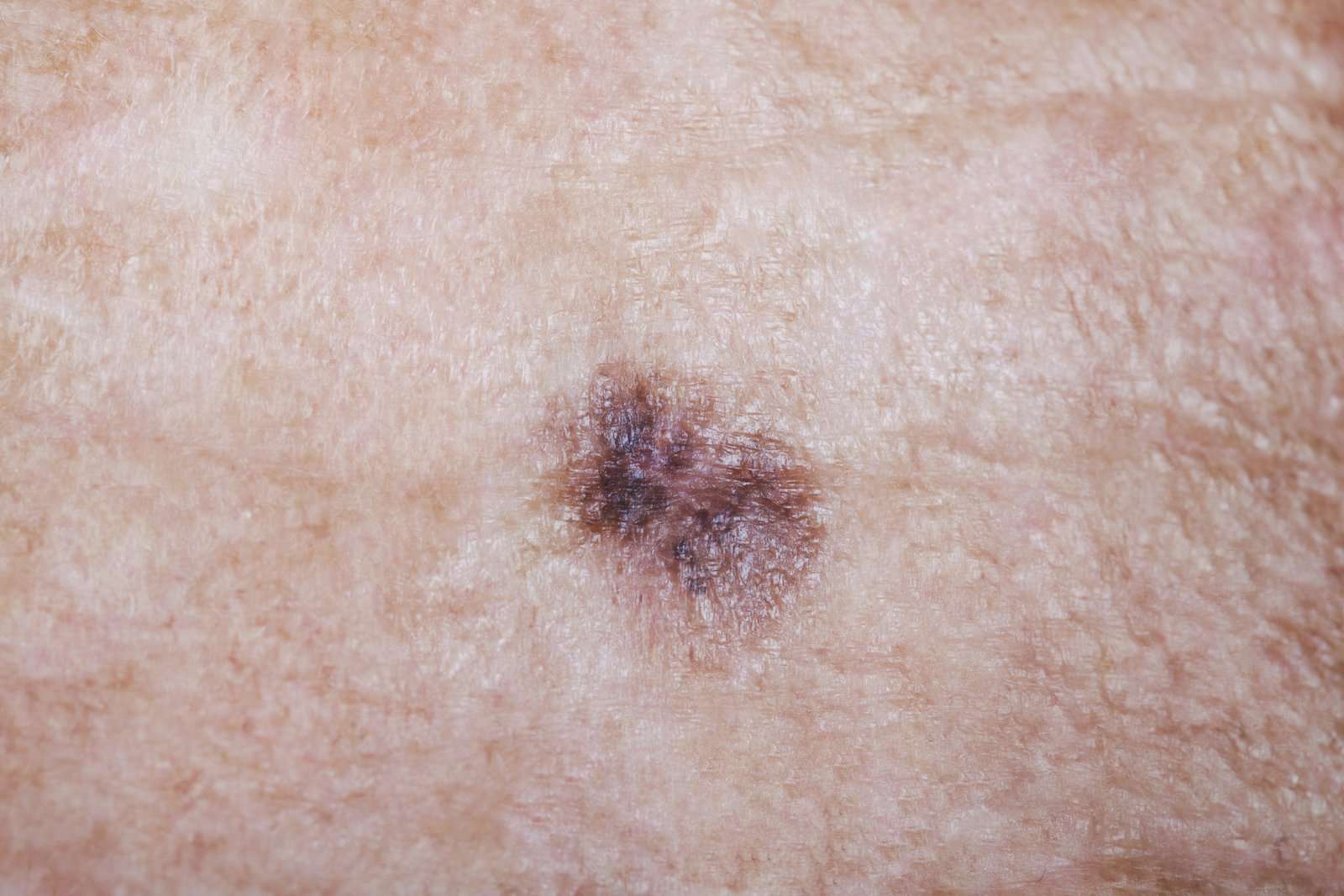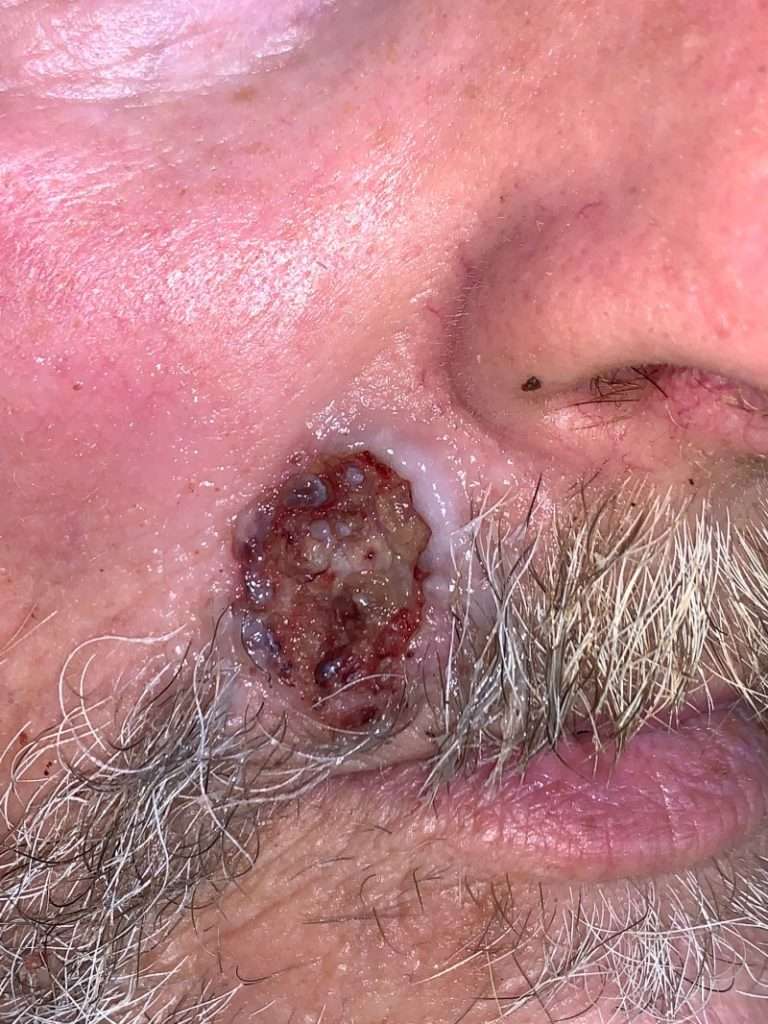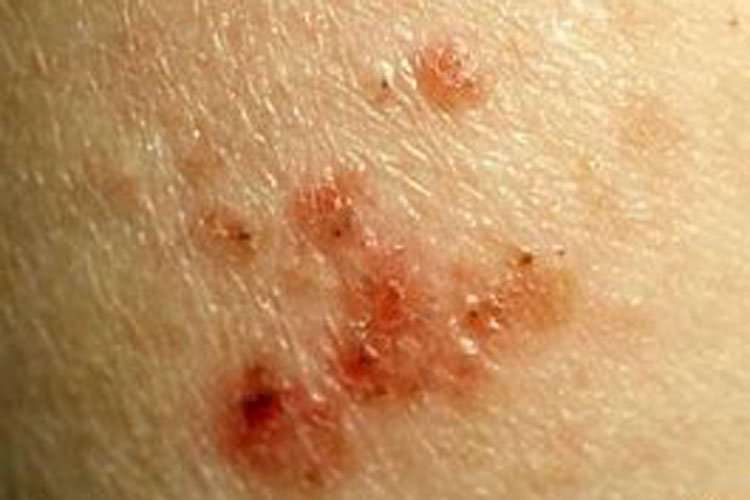Squamous Cell Carcinoma: Common In Sun
Squamous cell carcinoma, also called squamous cell cancer, is the second most common type of skin cancer. It accounts for about 20 percent of cases.
This type of cancer starts in flat cells in the outer part of the epidermis. It commonly crops up on sun-exposed areas, such as the face, ears, neck, lips, and hands. It can also develop on scars or chronic sores.
Squamous cell carcinomas may develop from precancerous skin spots, known as actinic keratosis .
These cancers might look like:
- A firm, red bump
- A flat lesion with a scaly, crusted surface
- A sore that heals and then reopens
People with lighter skin are more at risk for developing squamous cell carcinoma, but the skin cancer can also affect those with darker skin.
Other risk factors include:
- Having light eyes, blond or red hair, or freckles
- Being exposed to the sun or tanning beds
- Having a history of skin cancer
- Having a history of sunburns
- Having a weakened immune system
- Having the genetic disorder xeroderma pigmentosum
RELATED: 10 Things You May Know Cause Skin Cancer
Treatment Of Basal Cell Carcinoma
-
Removal of the tumor
Doctors may remove the cancer in the office by scraping and burning it with an electric needle or by cutting it out. Doctors may destroy the cancer by using extreme cold .
Certain chemotherapy drugs may be applied to the skin. Photodynamic therapy , in which chemicals and a laser are applied to the skin, also may be used. Occasionally, radiation therapy is used.
A technique called Mohs microscopically controlled surgery may be required for some basal cell carcinomas that are large or regrow or occur in certain areas, such as around the nose and eyes.
People whose cancer has spread to nearby tissues or spread to other parts of the body and who are not candidates for surgery or radiation therapy may be given the drug vismodegib or sonidegib taken by mouth.
Rarer Types Of Non Melanoma Skin Cancer
There are other less common types of skin cancer. These include:
- Merkel cell carcinoma
- T cell lymphoma of the skin
- Sebaceous gland cancer
These are all treated differently from basal cell and squamous cell skin cancers.
Merkel cell carcinoma
Merkel cell carcinoma is very rare. Treatment is with surgery or radiotherapy, or both. This usually works well, but sometimes the cancer can come back in the same place. And sometimes it spreads to nearby lymph nodes.
Sebaceous gland cancer
Sebaceous gland cancer is another rare type of skin cancer affecting the glands that produce the skin’s natural oils. Treatment is usually surgery for this type of cancer.
Kaposi’s sarcoma
Kaposis sarcoma is a rare condition. It’s often associated with HIV but also occurs in people who don’t have HIV. It’s a cancer that starts in the cells that form the lining of lymph nodes and the lining of blood vessels in the skin. Treatment is surgery or radiotherapy, and sometimes chemotherapy.
T cell lymphoma of the skin
T cell lymphoma of the skin can also be called primary cutaneous lymphoma. It’s a type of non Hodgkin lymphoma. There are a number of different types of treatment for this type of cancer.
Read Also: Does Skin Cancer Burn And Itch
When To Seek Medical Care For Skin Cancer
Many people, especially those who have fair coloring or have had extensive sun exposure, periodically check their entire body for suspicious moles and lesions.
Have your primary health care provider or a dermatologist check any moles or spots that concern you.
See your health care provider to check your skin if you notice any changes in the size, shape, color, or texture of pigmented areas .
If you have skin cancer, your skin specialist or cancer specialist will talk to you about symptoms of metastatic disease that might require care in a hospital.
What Is The Staging For Basal Cell Skin Cancer

Basal cell carcinomas rarely spread so they are not typically staged. If the tumor is large and it is suspected of spreading to other parts of the body, then staging may be used.
Staging for basal cell carcinomas is similar to the staging for another type of skin cancer called squamous cell carcinoma :
- Stage 0: Cancer involves only the epidermis and has not spread to the dermis .
- Stage I: Cancer is not large and has not spread to the lymph nodes or other organs.
- Stage II: Cancer is large but has not spread to lymph nodes or other organs.
- Stage III: Cancer has spread to tissues beneath the skin such as muscle, bone, or cartilage, and/or to regional lymph nodes but not to other organs.
- Stage IV: Cancer can be any size and has spread to other organs.
Don’t Miss: What Is The Most Aggressive Skin Cancer
Prognosis Of Basal Cell Carcinoma
Treatment of basal cell carcinoma is nearly always successful, and the cancer is rarely fatal. However, almost 25% of people with a history of basal cell carcinoma develop a new basal cell cancer within 5 years of the first one. Thus, anyone with one basal cell carcinoma should have a yearly skin examination.
What Does Skin Cancer Look Like
Basal cell carcinoma
-
BCC frequently develops in people who have fair skin. People who have skin of color also get this skin cancer.
-
BCCs often look like a flesh-colored round growth, pearl-like bump, or a pinkish patch of skin.
-
BCCs usually develop after years of frequent sun exposure or indoor tanning.
-
BCCs are common on the head, neck, and arms however, they can form anywhere on the body, including the chest, abdomen, and legs.
-
Early diagnosis and treatment for BCC are important. BCC can grow deep. Allowed to grow, it can penetrate the nerves and bones, causing damage and disfigurement.
Squamous cell carcinoma of the skin
-
People who have light skin are most likely to develop SCC. This skin cancer also develops in people who have darker skin.
-
SCC often looks like a red firm bump, scaly patch, or a sore that heals and then re-opens.
-
SCC tends to form on skin that gets frequent sun exposure, such as the rim of the ear, face, neck, arms, chest, and back.
-
SCC can grow deep into the skin, causing damage and disfigurement.
-
Early diagnosis and treatment can prevent SCC from growing deep and spreading to other areas of the body.
SCC can develop from a precancerous skin growth
-
People who get AKs usually have fair skin.
-
AKs usually form on the skin that gets lots of sun exposure, such as the head, neck, hands, and forearms.
-
Because an AK can turn into a type of skin cancer, treatment is important.
Melanoma
Recommended Reading: Soderstrom Skin Cancer Screening
How To Spot A Bcc: Five Warning Signs
Check for BCCs where your skin is most exposed to the sun, especially the face, ears, neck, scalp, chest, shoulders and back, but remember that they can occur anywhere on the body. Frequently, two or more of these warning signs are visible in a BCC tumor.
Please note: Since not all BCCs have the same appearance, these images serve as a general reference to what basal cell carcinoma looks like.
An open sore that does not heal
A reddish patch or irritated area
A small pink growth with a slightly raised, rolled edge and a crusted indentation in the center
A shiny bump or nodule
A scar-like area that is flat white, yellow or waxy in color
Skin Cancer Is The Most Common Type Of Cancer In The United States By A Pretty Large Margin And It Does Not Discriminate
See pictures of skin cancer and get the facts on skin cancer symptoms, signs, treatment, prevention, causes , and types . According to the american cancer society, just over 100,000 new cases of skin cancer are diagnosed in the united states each year. The diagnosis of skin cancer is usually made with either a shave, punch, or excisional biopsy, with further tests such as ct, mri, and pet for staging. The strongest risk factor for developing skin cancer is ultraviolet ray exposure, typically from the sun. What does skin cancer look like? See before and after photos of patients who have undergone reconstructive plastic surgery after skin cancer removal . Being armed with information is vital to begin the fight. Not only does the stage tell you how serious the disease is, but it can help you and. Melanoma is associated with infrequent but excessive sunbathing that causes scorching sunburn. Some types of skin cancer are more dangerous than others, but if you have a spot. Did you know that the most common form of cancer in the united states is skin cancer? Skin cancer is one of the most common types of cancer. A cancer diagnosis can leave you unable to comprehend anything else your doctor says, but it’s important to pay attention to what stage of cancer you have.
Don’t Miss: Basal Skin Cancer Survival Rates
Questions To Ask The Doctor
- Do you know the stage of the cancer?
- If not, how and when will you find out the stage of the cancer?
- Would you explain to me what the stage means in my case?
- What will happen next?
There are many ways to treat skin cancer. The main types of treatment are:
- Surgery
- Immunotherapy
- Chemotherapy
Most basal cell and squamous cell cancers can be cured with surgery or other types of treatments that affect only the spot on the skin.
The treatment plan thats best for you will depend on:
- The stage and grade of the cancer
- The chance that a type of treatment will cure the cancer or help in some way
- Your age and overall health
- Your feelings about the treatment and the side effects that come with it
Nevoid Basal Cell Carcinoma Syndrome
In addition to basal cell carcinoma, this autosomal dominant disorder can result in the early formation of multiple odontogenic keratocysts, palmoplantar pitting, intracranial calcification, and rib anomalies. Various tumors such as medulloblastomas, meningioma, fetal rhabdomyoma, and ameloblastoma also can occur.
Odontogenic keratocysts, palmoplantar pitting, intracranial calcification, and rib anomalies may be seen. Mutations in the hedgehog signaling pathway, particularly the patched gene, are causative.
Read Also: How Many People Die From Skin Cancer Every Year
Don’t Miss: Squamous Cell Carcinoma Skin Metastasis
Basal Cell Skin Cancer
BCC is the most common type of skin cancer. About 75 out of every 100 non melanoma skin cancers are BCCs. They develop from basal cells and these are found in the deepest part of the outer layer of the skin .
They develop mostly in areas of skin exposed to the sun, including parts of the face such as the nose, forehead and cheeks. Also, on your back or lower legs.
They are most often diagnosed in people who are middle aged or older.
Doctors might also call a basal cell cancer a rodent ulcer.
There are a number of different types of BCC. Each type can look and behave differently. They include:
- nodular basal cell skin cancer
- superficial basal cell skin cancer
- morphoeic basal cell skin cancer also known as sclerosing or infiltrating basal cell skin cancer
- pigmented basal cell skin cancer
Nodular basal cell cancer is the most common subtype.
Its very rare for basal cell skin cancer to spread to another part of the body to form a secondary cancer. Its possible to have more than one basal cell cancer at any one time and having had one does increase your risk of getting another.
Laser Surgery Is Not Fda

Laser surgery is not currently used as a standard treatment for basal cell carcinoma or squamous cell carcinoma. It can, however, be an effective secondary treatment. Laser treatment is sometimes used after Mohs surgery to complete the removal of cancer cells. Lasers are effective at removing precancerous lesions, but have not been proven effective at treating cancer yet.
Also Check: How To Identify Basal Cell Carcinoma
Four Reasons To Treat Basal Cell Carcinoma
Even when lesions from basal cell carcinoma on your skins surface dont appear to be changing, the cancer might still be growing. Some BCCs grow in irregular patterns under the skin, making the cancer seem smaller than it is. The cancer can affect tissue and bones. While major organs are rarely affected, muscle and nerve damage can occur, according to the Skin Cancer Foundation.
When not treated, the growth of the cancer can cause disfigurement because of internal damage. Treatment, which usually includes excision of the tumor, can be quite extensive when the cancer continues to grow unchecked. The longer you wait, the more damage and disfigurement the tumor can do and the more difficult it is to treat without causing cosmetic issues, according to Rex Amonette, M.D., the co-founder of The Skin Cancer Foundation.
When treated early, BCC is highly curable. Mohs surgery, a common treatment for BCC, has a cure rate of 99 percent. Excision, where the physician cuts out the growth, has a cure rate above 95 percent.
Most treatments for BCC are done as outpatient and often can be performed in your doctors office. Treatment does not usually involve extended time away from work or family.
What Is Basal Cell Carcinoma
Basal cell carcinoma is the most common form of skin cancer, with approximately 80% of skin cancers developing from basal cells. The epidermis has three types of cells. The cells in the bottom layer of the epidermis are the basal cells.
Basal cells consistently divide to form new cells. These replace squamous cells, pushing old cells towards the skin’s surface, where they die and slough off. Cancers that start in this bottom/basal layer of skin cells are called basal cell carcinoma.
Basal cell carcinoma is usually triggered by damage from ultraviolet radiation. This is most commonly from either exposure to the sun or tanning beds. UV radiation can damage basal cells, causing them to change and grow uncontrollably.
Basal cell carcinoma can look different from person to person. It may present as an open sore, scaly patch, shiny bump, a red irritated patch, pink growth, waxy scar-like growth, or a growth that dips in the center. They can sometimes ooze, crust, or bleed
As it can vary in how it looks, it is essential to get any new growths, lesions, lumps, bumps, or changes of your skin checked by your doctor.
Also Check: Does Amelanotic Melanoma Blanch When Pressed
Basal Cell And Squamous Cell Survival Rates
Because basal cell and squamous cell carcinomas are lower-risk skin cancers, theres little information on survival rates based on stage.
Both types of cancer have a very high cure rate. According to the Canadian Cancer Society, the five-year survival rate for basal cell carcinoma is 100 percent. The five-year survival rate for squamous cell carcinoma is 95 percent.
Get To Know Your Skin And Check It Regularly
Look out for changes such as:
- A mole that changes shape, color, size, bleeds, or develops an irregular border
- A new spot on the skin that changes in size, shape, or color
- Sores that don’t heal
- New bumps, lumps, or spots that don’t go away
- Shiny, waxy, or scar type lesions
- New dark patches of skin that have appeared
- Rough, red, scaly, skin patches
If you notice any changes to your skin, seek advice from a medical professional. Basal cell carcinoma is very treatable when caught early.
You May Like: Amelanotic Melanoma Blanch
What Is A Basal Cell
One of three main types of cells in the top layer of the skin, basal cells shed as new ones form. BCC most often occurs when DNA damage from exposure to ultraviolet radiation from the sun or indoor tanning triggers changes in basal cells in the outermost layer of skin , resulting in uncontrolled growth.
How Serious Is Basal Cell Skin Cancer
Basal cell skin cancer, also called basal cell carcinoma, is usually very curable, but it can cause disfigurement and complications if it’s not treated. In the majority of cases, basal cell carcinoma is very treatable.
It is unusual for basal cell carcinoma to cause death. Approximately 2,000 people in the U.S. die each year from basal and squamous skin cancers. In most cases, people who die from these types of skin cancer tend to be older, immunosuppressed, or have been diagnosed at a very late stage.
Recommended Reading: How To Identify Basal Cell Carcinoma
What Is The Life Expectancy For Basal Cell Skin Cancer
The prognosis for patients with basal cell carcinoma is very good, and the 5-year recurrence rate is about 5%. The cancer rarely spreads so patients can generally expect a normal life expectancy if doctors treat their cancer promptly.
Advanced basal cell carcinoma is rare, however, if the cancer is allowed to progress, it can cause significant illness.
Visit Us Dermatology Partners

If youve been diagnosed with skin cancer or are concerned about a lesion that may be cancerous, contact U.S. Dermatology Partners to schedule an appointment right away. You can complete our online scheduling request any time, and one of our team members will be in touch to finalize your appointment details. We care deeply about you and the health of your skin!
Find a location near me
Sign Up for Our Newsletter!
Get the latest updates on news, specials and skin care information.
Don’t Miss: Does Skin Cancer Make You Lose Hair